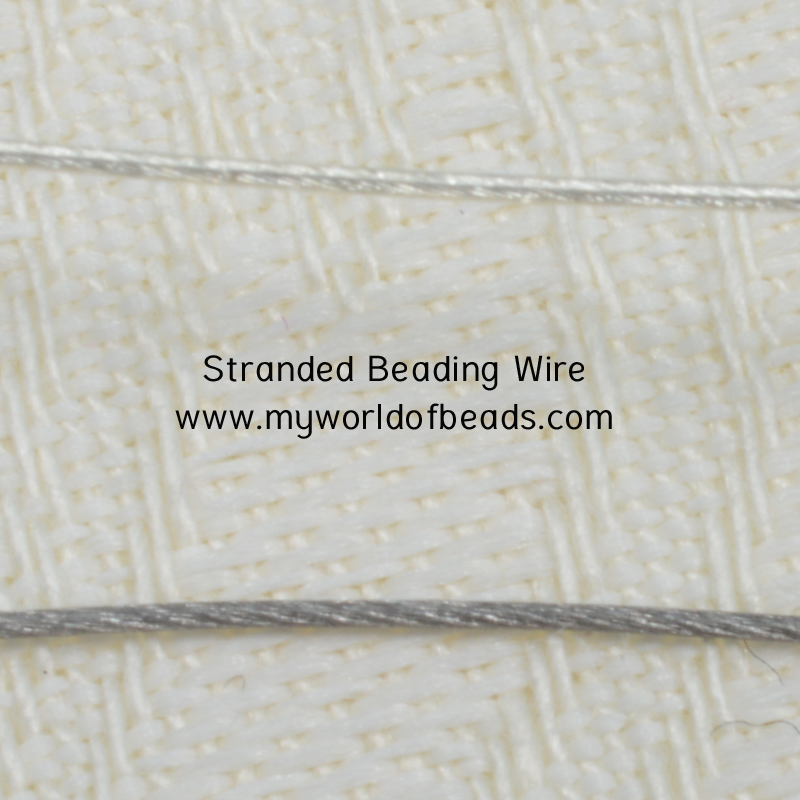Stranded Wire for Beading
Stranded wire is something you may want to use if you wish to make jewelry. It is super-strong, but also flexible. So, this makes it perfect for stringing to create necklaces and bracelets. Let me tell you a little more about it.
What is stranded wire?
Basically, this is a ‘cable’ formed from multiple strands of very fine wire. So, when they’re bound together, you get a really strong product, but it’s still fine enough to fit through even small bead holes.
You’ll find a few different brands and manufacturers. You may also see this talked about by the manufacturer’s name. So, for example, Beadalon. They are the manufacturer/brand, but this has also become a recognised name for the product. Tigertail(TM) is another common brand name.

The Tigertail (TM) is formed from 7 strands of wire, encased in nylon. So, it comes in a wide range of colours.
Beadalon is available in different strand sizes. The most common are 19-strand and 49 strand.
I also use Softflex wire – the Econoflex Pro brand is great. Like the other brands, it is nylon coated and you have a choice of colours and sizes.
Choosing the best wire
So, when you are choosing what to use, you will want to take into account both the size and the colour. It’s best to use a colour that will match or tone with your project. This could be something to match the beads, or it could be a gold or silver to match your other findings.
You will also want to consider the size and weight of the wire. It’s no surprise: the fewer the strands, the narrower the wire. So, you might want to bear that in mind if you’re using beads with tiny holes.
The weight is usually expressed as ‘test strength’. Basically, it is the weight that a single piece of the wire will carry without breaking. So, this is important for your stringing project. How heavy are the beads/stones you’re using? To be honest, I doubt they will be heavier than the test weight (or your jewellery might break your neck!). But it is worth knowing this stuff.

(The photo shows 19 strand Beadalon at the top, and 49 strand Econoflex Pro at the bottom)
Interpreting the information on your reel
Having just told you what to look for, where do you find this information?
Well, it’s all on your reel. So, you’ll see the ‘test strength’. That will help you decide what you need, depending on how heavy your beads are. This wire is suitable for stringing anything from plastic beads to seed beads to gemstones and crystals.
Then you’ll see the strand number. In theory, the more strands, the stronger the wire.
Finally, you’ll see the diameter. This is the width of the wire and is important in terms of your bead hole size. So, if you are working with tiny-holed beads, you’ll need a finer wire.

If you’re working from a pattern, the designer may have told you what they used. But maybe not. If you’re making up your own things, then you’ll need to use some common sense as you decide which product to buy.
Where can you buy stranded wire?
This is sold in any good bead shop. So, check out your local bead store. If you like to shop online, then this is a shop that I used and can recommend.
Shop owners will also be able to help and advise you if you have questions about what you’re getting.
How do you use it?
I started out by saying this is a product to use for stringing. I’ve also mentioned that you can string any kind of beads with it. So, how do you hold them in place and attach a clasp?
The answer is, with crimps. In this blog post, I’ve talked about crimp beads. They basically clamp around the wire to stop it from moving. So, you would use those to secure a clasp to either end of your stranded wire, with the beads strung along it.
It doesn’t have to be a clasp. I’ve used this wire to string sections of beadwork onto split rings, then added a bead-woven rope, in some designs. So, there’s a lot of options.
If you check out this video, I’ve shown you how to create a strung necklace. You might also like to check out the other posts in the jewellery making section on this blog.

What next?
If this has been helpful, then remember to check out the other posts in the jewellery making section on this website. I’m adding new stuff all the time. So, if you want to be sure you don’t miss anything, please join my mailing list. I send you a monthly email with all the new posts for that month. Plus you get a free gift when you join up. So, if that sounds good, click here to find out more.










Thank you Katie! I look forward to these blogs, which are always really informative and so useful